2023年中考英语复习时态讲练课件(共25张PPT)
文档属性
| 名称 | 2023年中考英语复习时态讲练课件(共25张PPT) | 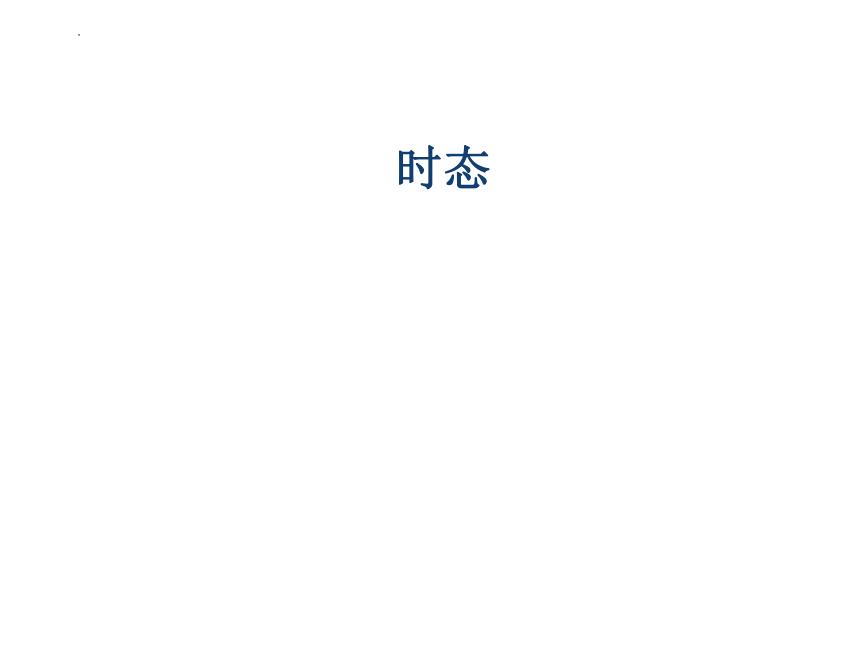 | |
| 格式 | pptx | ||
| 文件大小 | 118.7KB | ||
| 资源类型 | 教案 | ||
| 版本资源 | 通用版 | ||
| 科目 | 英语 | ||
| 更新时间 | 2023-06-21 18:14:07 | ||
图片预览

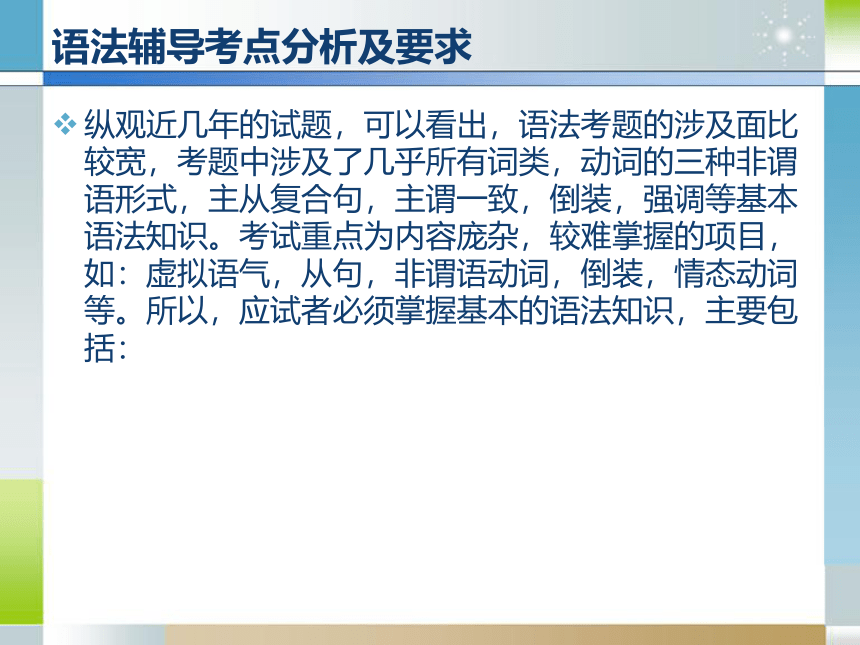
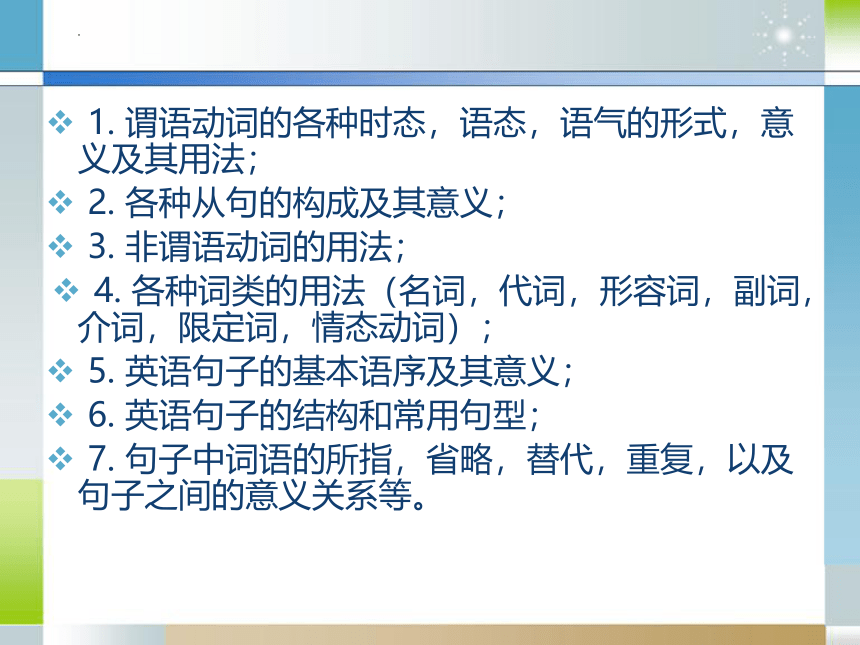
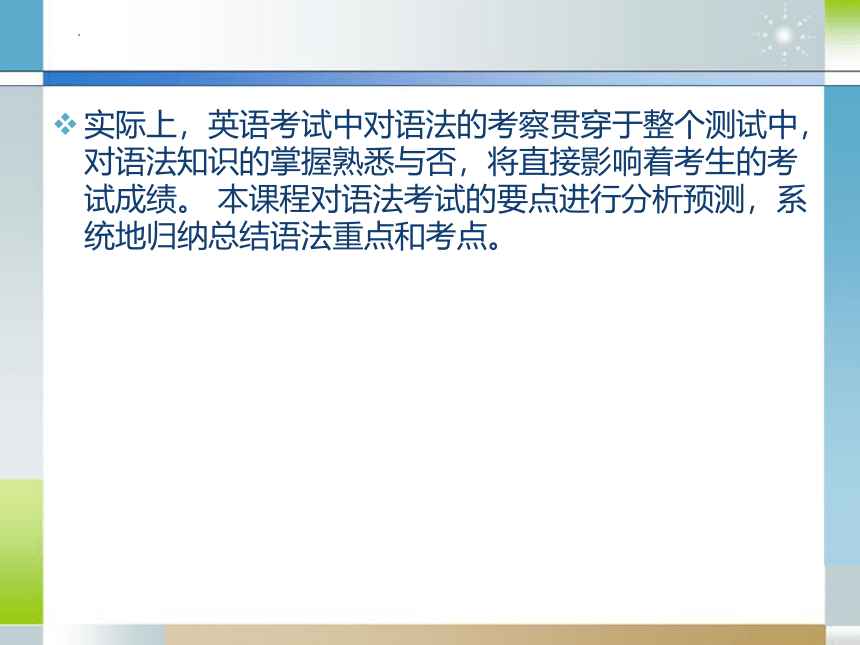
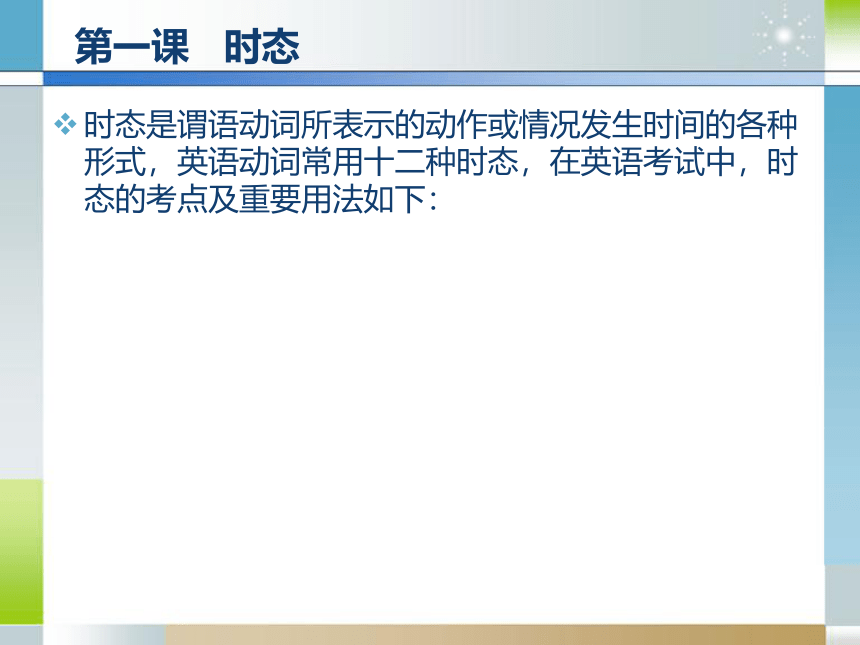
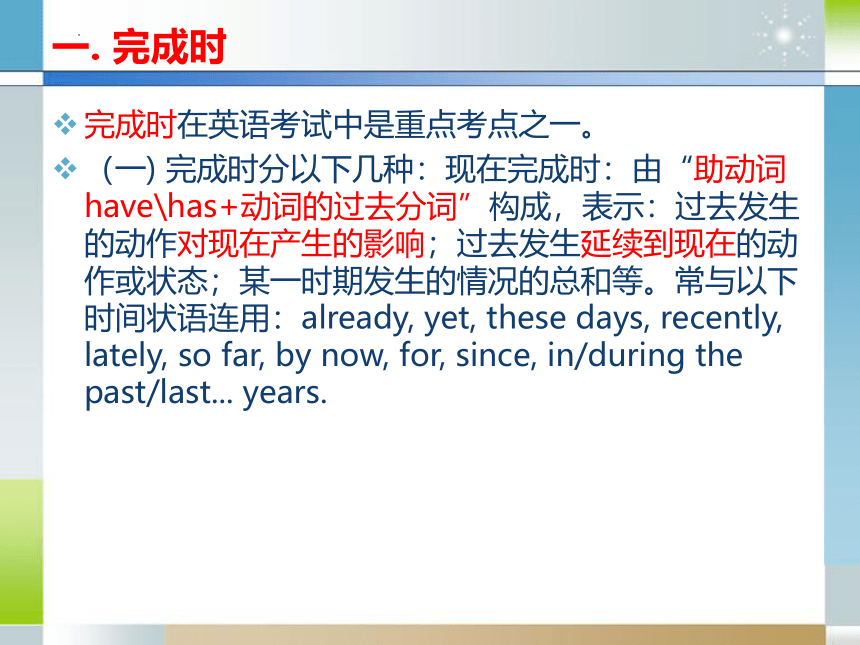


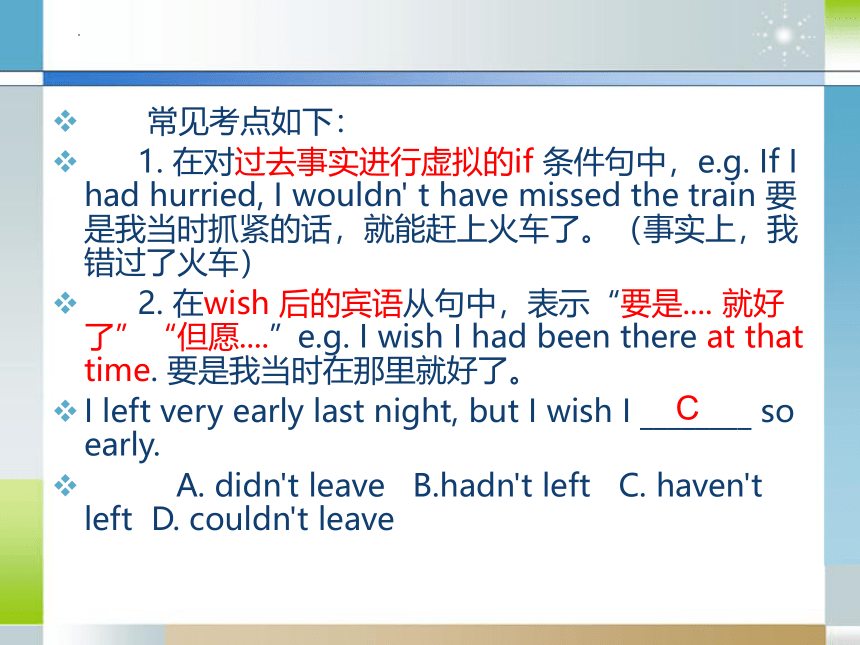
文档简介
(共25张PPT)
时态
语法辅导考点分析及要求
纵观近几年的试题,可以看出,语法考题的涉及面比较宽,考题中涉及了几乎所有词类,动词的三种非谓语形式,主从复合句,主谓一致,倒装,强调等基本语法知识。考试重点为内容庞杂,较难掌握的项目,如:虚拟语气,从句,非谓语动词,倒装,情态动词等。所以,应试者必须掌握基本的语法知识,主要包括:
1. 谓语动词的各种时态,语态,语气的形式,意义及其用法;
2. 各种从句的构成及其意义;
3. 非谓语动词的用法;
4. 各种词类的用法(名词,代词,形容词,副词,介词,限定词,情态动词);
5. 英语句子的基本语序及其意义;
6. 英语句子的结构和常用句型;
7. 句子中词语的所指,省略,替代,重复,以及句子之间的意义关系等。
实际上,英语考试中对语法的考察贯穿于整个测试中,对语法知识的掌握熟悉与否,将直接影响着考生的考试成绩。 本课程对语法考试的要点进行分析预测,系统地归纳总结语法重点和考点。
第一课 时态
时态是谓语动词所表示的动作或情况发生时间的各种形式,英语动词常用十二种时态,在英语考试中,时态的考点及重要用法如下:
一. 完成时
完成时在英语考试中是重点考点之一。
(一) 完成时分以下几种:现在完成时:由“助动词have\has+动词的过去分词”构成,表示:过去发生的动作对现在产生的影响;过去发生延续到现在的动作或状态;某一时期发生的情况的总和等。常与以下时间状语连用:already, yet, these days, recently, lately, so far, by now, for, since, in/during the past/last... years.
常见考点如下:
1. It has been + 一段时间+ since ...
2. This/It is +最高级/序数词+that从句,从句中的谓语部分用现在完成时,e,g, It isn't the first time that I have found myself in an embarrassing situation.我已经不是第一次发现自己处境尴尬了。
It is the third time I ______ to the Palace Museum, and I still think it is marvelous.
A. have gone B. go C. have been
D. wll go
C
( 二 )过去完成时:由“助动词had+动词的过去分词”构成,表示:在过去某个时刻之前已经完成的动作或状态。常与以下时间状语连用:by+过去某个时间点,如by2022; by the end of last year\month\week\term..... ; by the time\when+ 过去时。
常见考点如下:
1. 在对过去事实进行虚拟的if 条件句中,e.g. If I had hurried, I wouldn' t have missed the train 要是我当时抓紧的话,就能赶上火车了。(事实上,我错过了火车)
2. 在wish 后的宾语从句中,表示“要是.... 就好了”“但愿....”e.g. I wish I had been there at that time. 要是我当时在那里就好了。
I left very early last night, but I wish I ________ so early.
A. didn't leave B.hadn't left C. haven't left D. couldn't leave
C
3. This\It wasthe first\second time that..从句中的谓语部分用过去完成时,e.g. This was the third time that he had made the same mistake. 这是他第三次犯同样的错误了。
4. Hardly\Scarcely.... When... 或 No sooner... than.......,e.g. No sooner had he gone to sleep than the telephone rang once more. 他刚刚睡着,电话铃声再次响起。
5. Plan, think, intend, hope, want, mean 等用过去完成时,表示“打算做而没有做的事情”, e.g. We had planned to attend the meeting, but we changed our mind. 我们本打算参加会议的,但是我们改变主意了。
( 三 )将来完成时:由“助动词will have +动词的过去分词”构成, 表示在将来某一时刻之前或某个动作发生前另一个动作将要结束;有时也表示一种推测,常与以下时间状语连用:by\by the end of +将来时间.
By this time next week,the winners ___________ their awards.
A. will have receive B. Will be received
C. will have received D.will have been received
C
( 四 )现在完成进行时:由“助动词have\has+been+动词的现在分词”构成,表示:从过去某时刻开始的动作一直持续续到说话时还在进行或可能还继续下去。常与表示一段时间的状语连用。
E.g. He's been working for the company for 15years. 他已经为该公司工作工作15年了。
Even though they __________ side by side for twenty years, the two neighbours are not on good terms.
A. have been lived B. had been living
C. had been lived D.have been living
The manager _______ a rise in salary for ages, but nothing has happened yet.
A. is promised B.is promising
C. has been promising D.promised
B
C
( 五 )过去完成进行时:由“助动词had+been+动词的现在分词”构成,表示:从过去某时刻开始的动作一直持续续到过去的另一时间或可能还继续下去。
E.g. When his father returned home, the little boy had been flying a kite for two hours.
He told me that the lawyers had been arguing the case since eight o'clock in the morning.
( 六 )将来完成进行时:由“助动词will have +been+动词的现在分词”构成, 表示从某一时刻开始一直持续到将来某一时间。
E.g. By next month he will have been working in our factory for 30 years.
By the time your plane lands tonight , I ___________ at the airport for 10 hours.
A. had waited B.have been waited
C. had been waiting
D. will have been waiting
B
二. 一般现在时
表示现在存在的特征和状态,习惯动作,经常性动作或表示普遍真理及谚语,通常与表示频率的时间状语连用。如:every week, on Sundays, sometimes, usually, often, twice a week .
考点:当主句用一般将来时,其条件或时间状语从句中可用一般现在时。
E.g. It will be 33 years before we have a chance of seeing the star again.
As long as you _________ the money back promptly, I'll lend it to you with pleasure.
A. return B.will return
C . have returned D.returned
D
三. 一般过去时
常与以下时间状语连用:an hour ago, the other day, in 1987,last year... , just now, in those days 等。
表示:过去某个时间发生或存在的动作、过去经常发生或偶尔发生的动作。
常见考点如下:
1. 在It is time that...(某人该做某事了)的that 从句中的谓语动词用过去时。E.g. It is time that you went to bed.= It is time for you to go to bed.
2. 注意区分used to do (过去常做)和get\be\become used to doing sth. (习惯于做某事)
My sister is used to _______ with all the windows open. A. sleep B. have slept C. sleeping D. Slept
A
四. 一般将来时
表示将来某时间要发生的事或存在的状态,也可表示将来经常或反复发生的动作,常与表示将来的时间状语连用。表示方法多样:
1. will\shall do 将来的动作或状态
2. be going to do 最近打算要做的事或可能要发生的事
3. be to do 必须按计划要进行的
4. be about to do 即将发生(不加将来的时间状语)
5. be doing (常与arrive, leave, come, start)
No one ______ this building without the permission of the police.
A. is leaving B. will be leaving
C. has left D. is to leave
You _________ the difficulties after I explain the whole thing to you.
A. will be seen B. will have seen
C. will see D. see
A
C
五. 过去将来时
表示:从过去某时刻看将要发生的动作,常与宾语从句连用,也可表示过去习惯性动作。如:
When he was a child , he would sit there reading for hours.
六.现在进行时
表示:1. 现在某时刻正在进行的动作
2. being+adj. \n.表示一种暂时的特征或表现,有一定的感彩e.g. You are being naughty, Tom. Good boys never do that.
3.表将来的按计划,安排要发生的事或即将开始。
七.过去进行时
表示过去某时刻正在进行的动作。
与always, constantly,forever等状语连用时带有感彩,如:She was always finding fault with me. 她总是挑我的毛病。
时态
语法辅导考点分析及要求
纵观近几年的试题,可以看出,语法考题的涉及面比较宽,考题中涉及了几乎所有词类,动词的三种非谓语形式,主从复合句,主谓一致,倒装,强调等基本语法知识。考试重点为内容庞杂,较难掌握的项目,如:虚拟语气,从句,非谓语动词,倒装,情态动词等。所以,应试者必须掌握基本的语法知识,主要包括:
1. 谓语动词的各种时态,语态,语气的形式,意义及其用法;
2. 各种从句的构成及其意义;
3. 非谓语动词的用法;
4. 各种词类的用法(名词,代词,形容词,副词,介词,限定词,情态动词);
5. 英语句子的基本语序及其意义;
6. 英语句子的结构和常用句型;
7. 句子中词语的所指,省略,替代,重复,以及句子之间的意义关系等。
实际上,英语考试中对语法的考察贯穿于整个测试中,对语法知识的掌握熟悉与否,将直接影响着考生的考试成绩。 本课程对语法考试的要点进行分析预测,系统地归纳总结语法重点和考点。
第一课 时态
时态是谓语动词所表示的动作或情况发生时间的各种形式,英语动词常用十二种时态,在英语考试中,时态的考点及重要用法如下:
一. 完成时
完成时在英语考试中是重点考点之一。
(一) 完成时分以下几种:现在完成时:由“助动词have\has+动词的过去分词”构成,表示:过去发生的动作对现在产生的影响;过去发生延续到现在的动作或状态;某一时期发生的情况的总和等。常与以下时间状语连用:already, yet, these days, recently, lately, so far, by now, for, since, in/during the past/last... years.
常见考点如下:
1. It has been + 一段时间+ since ...
2. This/It is +最高级/序数词+that从句,从句中的谓语部分用现在完成时,e,g, It isn't the first time that I have found myself in an embarrassing situation.我已经不是第一次发现自己处境尴尬了。
It is the third time I ______ to the Palace Museum, and I still think it is marvelous.
A. have gone B. go C. have been
D. wll go
C
( 二 )过去完成时:由“助动词had+动词的过去分词”构成,表示:在过去某个时刻之前已经完成的动作或状态。常与以下时间状语连用:by+过去某个时间点,如by2022; by the end of last year\month\week\term..... ; by the time\when+ 过去时。
常见考点如下:
1. 在对过去事实进行虚拟的if 条件句中,e.g. If I had hurried, I wouldn' t have missed the train 要是我当时抓紧的话,就能赶上火车了。(事实上,我错过了火车)
2. 在wish 后的宾语从句中,表示“要是.... 就好了”“但愿....”e.g. I wish I had been there at that time. 要是我当时在那里就好了。
I left very early last night, but I wish I ________ so early.
A. didn't leave B.hadn't left C. haven't left D. couldn't leave
C
3. This\It wasthe first\second time that..从句中的谓语部分用过去完成时,e.g. This was the third time that he had made the same mistake. 这是他第三次犯同样的错误了。
4. Hardly\Scarcely.... When... 或 No sooner... than.......,e.g. No sooner had he gone to sleep than the telephone rang once more. 他刚刚睡着,电话铃声再次响起。
5. Plan, think, intend, hope, want, mean 等用过去完成时,表示“打算做而没有做的事情”, e.g. We had planned to attend the meeting, but we changed our mind. 我们本打算参加会议的,但是我们改变主意了。
( 三 )将来完成时:由“助动词will have +动词的过去分词”构成, 表示在将来某一时刻之前或某个动作发生前另一个动作将要结束;有时也表示一种推测,常与以下时间状语连用:by\by the end of +将来时间.
By this time next week,the winners ___________ their awards.
A. will have receive B. Will be received
C. will have received D.will have been received
C
( 四 )现在完成进行时:由“助动词have\has+been+动词的现在分词”构成,表示:从过去某时刻开始的动作一直持续续到说话时还在进行或可能还继续下去。常与表示一段时间的状语连用。
E.g. He's been working for the company for 15years. 他已经为该公司工作工作15年了。
Even though they __________ side by side for twenty years, the two neighbours are not on good terms.
A. have been lived B. had been living
C. had been lived D.have been living
The manager _______ a rise in salary for ages, but nothing has happened yet.
A. is promised B.is promising
C. has been promising D.promised
B
C
( 五 )过去完成进行时:由“助动词had+been+动词的现在分词”构成,表示:从过去某时刻开始的动作一直持续续到过去的另一时间或可能还继续下去。
E.g. When his father returned home, the little boy had been flying a kite for two hours.
He told me that the lawyers had been arguing the case since eight o'clock in the morning.
( 六 )将来完成进行时:由“助动词will have +been+动词的现在分词”构成, 表示从某一时刻开始一直持续到将来某一时间。
E.g. By next month he will have been working in our factory for 30 years.
By the time your plane lands tonight , I ___________ at the airport for 10 hours.
A. had waited B.have been waited
C. had been waiting
D. will have been waiting
B
二. 一般现在时
表示现在存在的特征和状态,习惯动作,经常性动作或表示普遍真理及谚语,通常与表示频率的时间状语连用。如:every week, on Sundays, sometimes, usually, often, twice a week .
考点:当主句用一般将来时,其条件或时间状语从句中可用一般现在时。
E.g. It will be 33 years before we have a chance of seeing the star again.
As long as you _________ the money back promptly, I'll lend it to you with pleasure.
A. return B.will return
C . have returned D.returned
D
三. 一般过去时
常与以下时间状语连用:an hour ago, the other day, in 1987,last year... , just now, in those days 等。
表示:过去某个时间发生或存在的动作、过去经常发生或偶尔发生的动作。
常见考点如下:
1. 在It is time that...(某人该做某事了)的that 从句中的谓语动词用过去时。E.g. It is time that you went to bed.= It is time for you to go to bed.
2. 注意区分used to do (过去常做)和get\be\become used to doing sth. (习惯于做某事)
My sister is used to _______ with all the windows open. A. sleep B. have slept C. sleeping D. Slept
A
四. 一般将来时
表示将来某时间要发生的事或存在的状态,也可表示将来经常或反复发生的动作,常与表示将来的时间状语连用。表示方法多样:
1. will\shall do 将来的动作或状态
2. be going to do 最近打算要做的事或可能要发生的事
3. be to do 必须按计划要进行的
4. be about to do 即将发生(不加将来的时间状语)
5. be doing (常与arrive, leave, come, start)
No one ______ this building without the permission of the police.
A. is leaving B. will be leaving
C. has left D. is to leave
You _________ the difficulties after I explain the whole thing to you.
A. will be seen B. will have seen
C. will see D. see
A
C
五. 过去将来时
表示:从过去某时刻看将要发生的动作,常与宾语从句连用,也可表示过去习惯性动作。如:
When he was a child , he would sit there reading for hours.
六.现在进行时
表示:1. 现在某时刻正在进行的动作
2. being+adj. \n.表示一种暂时的特征或表现,有一定的感彩e.g. You are being naughty, Tom. Good boys never do that.
3.表将来的按计划,安排要发生的事或即将开始。
七.过去进行时
表示过去某时刻正在进行的动作。
与always, constantly,forever等状语连用时带有感彩,如:She was always finding fault with me. 她总是挑我的毛病。
同课章节目录
- 词法
- 名词
- 动词和动词短语
- 动词语态
- 动词时态
- 助动词和情态动词
- 非谓语动词
- 冠词
- 代词
- 数词和量词
- 形容词副词及其比较等级
- 介词和介词短语
- 连词和感叹词
- 构词法
- 相似、相近词比较
- 句法
- 陈述句
- 一般疑问句和否定疑问句
- 特殊疑问句及选择疑问句
- 反意疑问句
- 存在句(There be句型)
- 宾语从句
- 定语从句
- 状语从句
- 主谓一致问题
- 简单句
- 并列句
- 复合句
- 主谓一致
- 主、表语从句
- 名词性从句
- 直接引语和间接引语
- 虚拟语气
- 感叹句
- 强调句
- 倒装句
- 祈使句
- 句子的成分
- 句子的分类
- 题型专区
- 单项选择部分
- 易错题
- 完形填空
- 阅读理解
- 词汇练习
- 听说训练
- 句型转换
- 补全对话
- 短文改错
- 翻译
- 书面表达
- 任务型阅读
- 语法填空
- 其他资料
